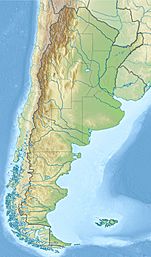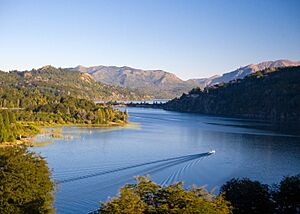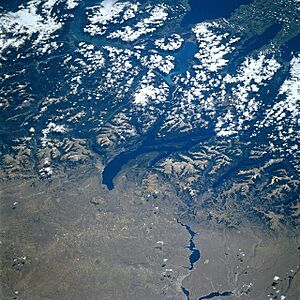Nahuel Huapi Lake facts for kids
Quick facts for kids Nahuel Huapi Lake |
|
|---|---|
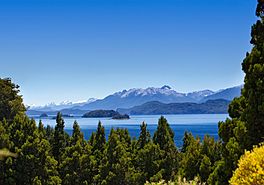 |
|
| Location | Los Lagos Department, Neuquén Province / Bariloche Department, Río Negro Province, Argentina, in Patagonia |
| Coordinates | 41°05′25″S 71°20′08″W / 41.09028°S 71.33556°W |
| Type | Glacial lake |
| Primary inflows | Huemul river Correntoso river Bonito river Machete river |
| Primary outflows | Limay River |
| Catchment area | 3,989 km2 (1,540 sq mi) |
| Basin countries | Argentina |
| Max. length | 76 km (47 mi) |
| Max. width | 10.1 km (6.3 mi) |
| Surface area | 530 km2 (205 sq mi) |
| Average depth | 157 m (515 ft) |
| Max. depth | 464 m (1,522 ft) deeper places might exist |
| Water volume | 83.35 km3 (20.00 cu mi) |
| Shore length1 | 357 km (222 mi) |
| Surface elevation | 2,523 ft (769 m) |
| Frozen | never |
| Islands | Isla Victoria Isla Huemul |
| Settlements | San Carlos de Bariloche Villa La Angostura |
| 1 Shore length is not a well-defined measure. | |
Nahuel Huapi Lake (Spanish: Lago Nahuel Huapí) is a large lake located in the Andes mountains. It's found in the northern part of Patagonia, a region in Argentina. The lake stretches between two provinces: Río Negro and Neuquén.
This lake has a long, narrow shape and a very interesting coastline with many branches, peninsulas (land almost surrounded by water), and islands. Two important cities are located on its shores: San Carlos de Bariloche to the south and Villa La Angostura to the northwest. The entire lake is part of the Nahuel Huapi National Park. It's one of the biggest lakes in northern Patagonia. Water flows out of the lake into the Limay River, which then joins the Negro River and eventually reaches the South Atlantic Ocean.
You might hear a curious story about a house on the lake's northwest shore. Some people believe that a famous historical figure, Adolf Hitler, might have lived there after 1945. This is a conspiracy theory and not a proven fact.
Contents
What Does "Nahuel Huapi" Mean?
The name of the lake comes from the biggest island in the lake. In the Mapudungun language, spoken by the Mapuche people, "Nahuel Huapi" means "Island of the Puma".
The word nahuel means 'puma', and huapí means 'island'. But there's more to it! "Nahuel" can also mean 'a person who has been changed into a puma by magic'.
Exploring the Geography of Nahuel Huapi Lake
Nahuel Huapi Lake is located inside the Nahuel Huapi National Park. It covers an area of about 530 km2 (200 sq mi). The lake sits 770 metres (2,510 ft) above sea level. In 2007, its deepest point was measured at 464 metres (1,522 ft).
Lake Branches and Islands
The lake has seven main branches, which are like long arms of water. These are named Blest, Huemul, de la Tristeza, Campanario, Machete, del Rincón, and Última Esperanza.
Nahuel Huapi Lake is also connected to other smaller lakes nearby. These include Gutiérrez, Moreno, Espejo, and Correntoso. The lake's clear, deep-blue waters are home to several islands. The most famous ones are Isla Victoria, which is quite large, and Isla Huemul at the southern end of the lake.
Water Temperature and Activities
The lake's clear waters are very sensitive to weather changes. The average temperature of the water surface is about 7 °C (45 °F). Because the water is so cold, it can be dangerous for swimmers. Hypothermia (when your body loses heat too quickly) is a risk if you stay in the water for too long.
Despite the cold, many people enjoy Kayaking on Nahuel Huapi and the lakes connected to it. The lake is also where the Limay River begins its journey.
How Nahuel Huapi Lake Was Formed
Geological History
The deep basin where Nahuel Huapi Lake sits was formed by glacial valleys. These valleys were carved out by huge glaciers moving along natural cracks in the Earth called faults. Later, these valleys were blocked by piles of rocks and dirt left behind by the glaciers, called moraines.
During the Last Glacial Maximum, which was the coldest part of the last Ice Age, the entire lake area was covered by a massive glacier.
Changing Water Colors
The lake's water is usually a beautiful blue color. However, sometimes its water can turn turquoise or green. This can happen after strong earthquakes in southern Chile, like the one on May 22, 1960, or the one on January 2, 2011.
In June 2011, a volcano called Puyehue-Cordón Caulle erupted in nearby Chile. This eruption caused parts of the lake's surface to be covered in volcanic ash.
Tiny Life in the Lake
In the winter, the main type of tiny plant life (called plankton) in the lake is Dictyosphaerium pulchellum. For the rest of the year, other types of algae, Bacillariophyceae and Chrysophyceae, are more common.
Animals Living in Nahuel Huapi Lake
Fish and Birds
Nahuel Huapi Lake is home to several types of introduced fish that are not native to the area. These include rainbow trout, brown trout, and brook trout. These fish are very popular with anglers (people who fish) who come from all over the world.
A surprising fact about the lake is that it's also home to birds usually found near the ocean. These include the kelp gull and the blue eyed cormorant (Phalacrocorax atriceps). It's unusual to find these birds so far from the sea and at such a high altitude!
Folklore and Mysteries of the Lake
The Legend of Nahuelito
At the beginning of the 20th century, an old local legend started to spread. People began to talk about a giant creature living in the deep waters of the lake. This mysterious creature is known as Nahuelito. Stories about Nahuelito were told even before the famous Nessie (the Loch Ness Monster) and before the book The Lost World (1912) by Arthur Conan Doyle.
The local Mapuche people had their own stories about a creature they called el Cuero (the leather) because of its smooth skin. Another nearby lake, Lago Lácar, also has stories of a creature. This one is described as a "sea-cow" with "teeth all around it," which sounds a bit like a plesiosaur.
In 1922, people from the Buenos Aires Zoo visited the lake. They wanted to see if there was any truth to the stories about a prehistoric animal. However, they didn't find any proof that such a creature existed.
The Hitler Conspiracy Theory
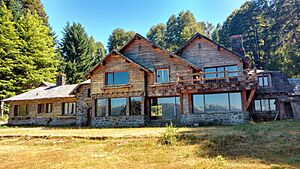
There's a theory that Adolf Hitler, a German political leader, might have escaped to Argentina after 1945. This theory suggests he lived in a house near Nahuel Huapi Lake.
The house, called Inalco, was designed in 1943. It was later sold to people who some believe helped individuals connected to the Nazi party. The house was eventually sold to a businessman linked to the Argentine president at the time, Juan Perón.
According to this theory, some German submarines brought certain people and treasures to Argentina. It is claimed that Hitler arrived in Argentina and first stayed at a place called Hacienda San Ramón, east of San Carlos de Bariloche. Then, he supposedly moved to the Bavarian-style mansion at Inalco. The theory even claims that Eva Braun, Hitler's partner, left him around 1954 and moved away with a daughter. This theory suggests Hitler died in February 1962.
TV shows like Hunting Hitler (2015–2018) have explored this theory. They found things like a guard tower and a destroyed bunker near the lake, which they suggested could have been used to protect the mansion. The mansion was hard to reach except by lake due to thick forests. The show also mentioned a nuclear project on Huemul Island, led by a German scientist.
In a 2018 episode of Expedition Unknown, the host, Josh Gates, visited the Inalco House. He found an old coin from the Nazi era on the grounds. This led him to believe that people connected to the Nazis might have used the house, but it doesn't prove Hitler himself lived there.
Gallery
See also
 In Spanish: Lago Nahuel Huapi para niños
In Spanish: Lago Nahuel Huapi para niños
- Limay River, a major river of the region that runs from the lake


